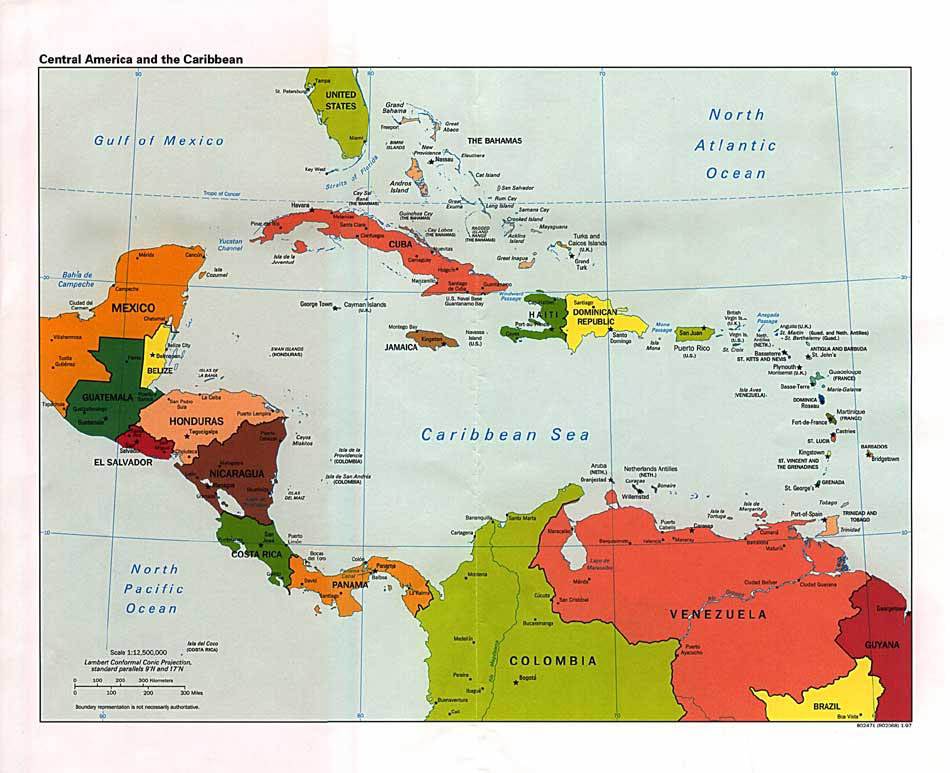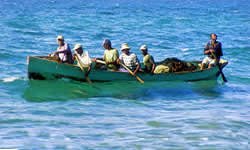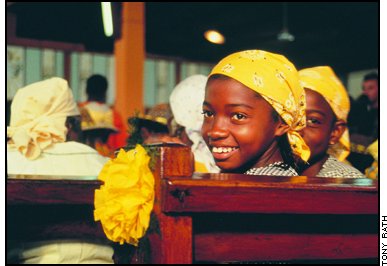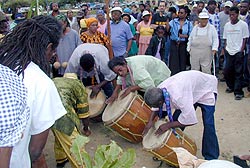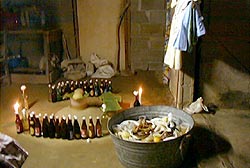In addition, the importance of the drum in Garifuna music is another similarity
to their African influence. Garifuna music relies heavily on the
drum, and in many instances their music is dictated by it. Often
times a particular drum style will call for two drummers (except for sacred
music, which usually uses three). Typically, one drummer will play a fixed,
consistent pattern. This drummer is usually called the segunda player. Their social and cultural characteristics are manifested in their archaic family and social structures, which have suffered very little changes. They still share their dialect, circular dances, religious practices, Punta dance, tales, banana cultivation, and rooster and pig sacrifices with the indigenous people of the Amazon.
CHUMBA
The Garifuna has always practiced spiritualism. It is believed that the life
of the Garifuna revolves around their spiritual tenets, belief in the power
of the spirits of their ancestors. Traditionally, Garinagu relied on the
spirits of their ancestor to guide them in their day-to-day activities. This
practice is believed to have kept the Garifuna family united as a race. One
of the characteristics of their ancestral worship is universality. This
phenomenon is evident in the ritual of the "Dugu". The songs and chanting
used to evoke the spirits of the ancestors in Honduras, Guatemala and
Nicaragua are the same.
Their ways of production are still based in subsistence farming. Among the different communities there is a great potential of production, and in most cases the land is very fertile for farming, however the only people involved are the elders because young people believe farming is not a great source of income. Youngsters are mostly dedicated to fishing, because most of the fish are set for sale and produce an immediate source of income. Youngsters show little or no interest in participating in social reunions with the rest of their community; elders and the women are usually the ones who interact with these reunions. It can be concluded that young Garifunas seem to be more interested in immigrating to North America.
Location: The Garifuna population that lives in the Atlantic Coast, between Belize and Nicaragua, is distributed in 43 towns and villages. Approximately 98,000 Garifunas live in Honduras, and they are mostly concentrated along the North coast from Masca, Cortés to Plaplaya, Gracias a Dios. Among other villages are: Santa Rosa de Aguan, Tornabé, Limón, Nueva Armenia, San Juán, Cosuna, Triunfo de la Cruz, and Baja Mar.
Health: Garinagu are health concious and practice uncommon habits and healing strange but effective remedies to maintain or regain good health. Until the last ten years many Garifuna communities lack of clinical establishments, illness prevention programs, and nutrition programs.
Housing: their housing in the past consist of small huts with walls made of royal palm, sugar cane. Now many homes are made from timber. pre-fabricated materials/homes and from cement blocks. The ceiling is commonly made of hay, however they also use zinc as a ceiling too. There is a great tendency to replace their traditional style of housing for more modern types; and, these changes have helped to further improve their health living conditions.
Politics: Garifunas do not believe in politics, they believe that they are too peaceful and that they can handle their personal problems without the intervention of any legal force; however, in some areas a governor is in charge of providing justice between the people. Many Garifuna especially in Belize are well educated and occupy government positions today.
Language: Most Garinagu not only speak Spanish, but also use the Igñeri dialect that is a combination of Arahuaco, French, Swahili, and Bantu.
Religion: Garinagu still maintain their own religious system that is a mixture of African and Amerindian traditions to which they have incorporated Catholic elements. Of great importance is the Garifuna religious system called Gubida and DUGU that is the conception of the dreams and possession rituals as altered states of conscience considered, by the participants and believers, to be caused by the possession of a spiritual entity.
Education: 72% of the population is literate or semi-literate. The home of the largest number of Garinagu teachers in the country of Belize is Seine Bight Village. Seine Bight Village has been known by many names, the one most frequently used being the "Home of Young Intelligent Folks". The village holds the reputation as the home of the largest number of Garifuna teachers of Belize. In the 1920's and the 1930's most of the Garifuna teachers throughout British Honduras (now Belize) were from in Seine Bight Village. The man responsible for the cultivation of that brood of teachers was Mr. Simeon Sampson Sr. who spent twenty-three years of his teaching career as Seine Bight Village teacher. They served their country and contributed with remarkable sense of duty and honor. Seine Bight Teachers
Throughout Central America, Garifuna culture is typically associated with a sensual dance style known as the Punta, exotic foods like machuca, rice and beans and casava, and the infectious and mesmerising drumming that can be heard up and down the isthmus’ Caribbean coast.
The survival of Garifuna culture over the centuries is a testament to the community’s strength of spirit. Despite the experience of intense physical hardship and strong acculturation pressures, the Garifuna maintain a distinct identity embodied in their unique language, religion and traditions. Their religion is a case in point. A mix of Roman Catholicism and traditional African and indigenous beliefs, Garifuna religious traditions have survived condemnation and attacks by outsiders, who accused the Garifuna population of involvement in practices ranging from devil worship to polygamy.
Today, the Garifuna population is more vibrant and dynamic than ever. In addition to their traditional vibrant communities such as Seine Bight, Hopkins, Dangriga in Belize and many others along the coast of, Guatemala, Honduras and Nicaragua, approximately 100,000 live in the United States, where they continue to maintain strong links with their homeland.
TRADITIONAL GARIFUNA DANCES
HUNGüHUNGü
This ritual dance is used as a means for the living to communicate with he dead. It is also performed on the feast day of Saint Isidore the Farmer (San Isidro Labrador), which is typically marked by the Garifuna with a street dance and other events.
www.seinebight.com/drumsdance.htm Another work of Ben Palacio
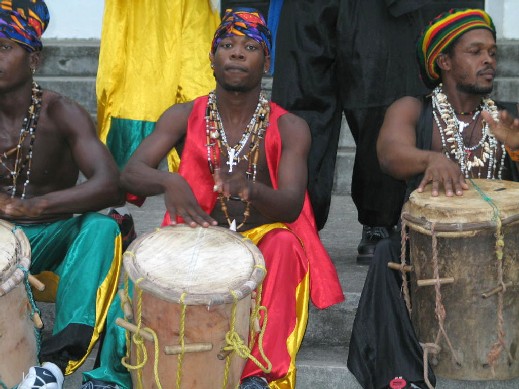
A dance with strong erotic undertones, this dance was traditionally performed exclusively by women, for whom it was a response to the objectification and humiliation they suffered at the hands of Europeans during the colonial era.
PUNTA
The best known of all Garifuna dances, the Punta is traditionally performed accompanied by the sound of drums (garajü) and maracas (sinsira).
WANARAGüA
This dance tells the story of how Garífuna women, dressed in men's clothing, defeated a force of European soldiers at a time when their menfolk were afraid to go into battle. Male dancers honor the women's bravery by donning female attire, while the Europeans are represented by dancers wearing white costumes and masks.
PARRANDA
Synonymous with celebration, the Parranda is performed at almost every Garifuna holiday.
GARIFUNA ARCHITECTURE
With the introduction of modern building materials, Garifuna villages typically include houses built of both concrete and thatched palm. Traditionally, however, all houses would have been built using exclusively local products, including logs for use as wall supports and hay that would provide thatch for the roof. Such houses were built without using a
single nail.

In St. Vincent eleven Garifuna villages were autonomous under the leadership
of a chief who was a "buyei", a chosen spiritual leader and healer. In times
of war final decisions were made only after all the chiefs had consulted
their spirit helpers, "Hiyuruha" in a special ceremony known to the Garifuna
as "Areiraguagüdüni". This is one of the Garifuna spiritual practices that
has accounted for Garifuna solidarity in the face of suppression. There is
never a time that a buyei is not chosen by the ancestral spirits to lead and
minister to the people when the need arises.
Stories of spiritual guidance and mysterious occurrences abound. Once in the
village of Seine Bight a farmer accompanied only by his dog suffered a
terrible cut while building a dory. Having bled profusely, the farmer became
helpless and motionless. The village Buyei having received the message from
his spiritual helpers immediately alerted the wife and family of the injured
man. Men from the village quickly traveled to the forest and rescued the
dory builder and saved his life.
* By Benjamin Palacio *
Gubida are spirits of ancestors who are contacted through the use of Buyeis who also act as spirit helpers during a ceremony for the dead. They lead the song and dance offering rum to the dead and this culminates in a burial at sea.
Celebrations and ceremony are important in the Garifuna culture. The burial feast is known as "Beluria" and is a nine-day devotional ceremony to the Dead, which culminates in drumming, dancing and feasting. (Gonzalez, Levinson, 1998). Dubu is a ritual feast to appease the spirits after someone dies. This lasts two to four days and consists of much feasting on cassava bread, plantains, rice, beans, cheese and port wine. The Dugu is a religious ceremony in which a high priest, the Buyei, leads the contact with deceased relatives. The purpose is to appeal to ancestors for help in resolving some family problem. The ancestral Spirit communicates with his people during an Owehani (Equivalent to the Pentecost). There are drummers, summoned by the Buyei and Gayusa (singers) and fishermen to gather seafood. Many days of preparation are need.
There are reports that rituals such as the Dugu have reinforced the cultural unity and spiritual beliefs of the Garinagu. When celebrated with the entire village, friends and relatives come together. (Garinagu Life in Central America, Garifuna World). Health is determined by power wielded by ancestral spirits, traditional folk remedies, and "bush medicine." The Garifuna are accused of voodooism, polygamy, devil worship and other evil by the cultures in Honduras.
The religion of the Garifuna is a combination of Catholicism, African and Indian beliefs. The rites of passage are celebrated: births, arrival of puberty, and death. These are traditionally celebrated by the community and include special music and songs. Work songs, hymns, lullabies, ballads and healing songs are popular. The African influence is heard with complex drum rhythms and call-response patterns in songs. Holy days of the Catholic Church include processions, prayer, music, street dances and costumes.
